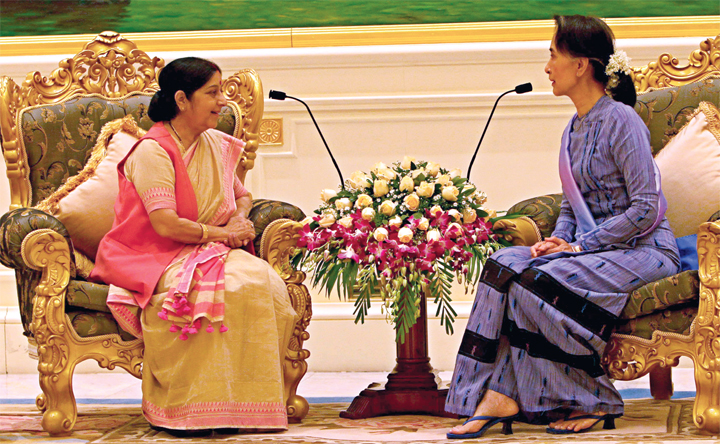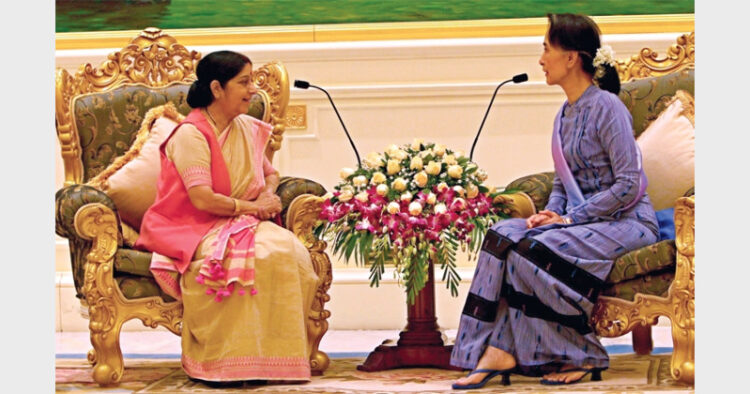 India and Myanmar have started re-engaging themselves on the economic front with increased vigour
India and Myanmar have started re-engaging themselves on the economic front with increased vigour
Sriharsha Masabathula from Yangon, Myanmar
India and Myanmar, two emerging nations nested in their own timelines of socio-economic and democratic transformations, are endowed with much historical, political, cultural and even geographic commonality, making the relationship quintessential to the foreign policy strategies of both the nations. Just before the visit of Myanmarese President to India, Hon’ble External Affairs Minister of India Smt Sushma Swaraj visited Myanmar on August 22, 2016. It was the first official high level bilateral visit from India to Myanmar since the formation of new government in Myanmar led by National League for Democracy (NLD).
In recent years, India and Myanmar have started re-engaging with increased vigour, and much of the focus has arguably been on covering ground lost before Myanmar’s transition to an
open-economy in recent years. Much has been achieved through consistent efforts to revive the intrinsic depth in the historically and culturally intertwined relationship, and both the nations stand at crucial crossroads, wherein it is
essential to recognise the strides made forward, and build further engagement on that basis. In other words, there is a need to look at India-Myanmar relations through a different lens. Perhaps, realising what has been achieved in recent years, albeit silently, will encourage critics to rethink the narrative surrounding a perceived lack of intimacy in this important bilateral relationship.
Notable progress has been made in various facets of the bilateral relationship between both the countries. On the economic and commerce front, bilateral trade of USD 328 million in 1997-98, has increased more than six-fold to USD 2.052 billion in 2015–16, with Myanmar becoming the second largest supplier of beans and pulses to India. Immense potential for even greater economic and trade cooperation with Myanmar in areas such as agricultural machinery, renewable energy, agrochemicals, ICT and IT-related products and services is foreseen . To support these endeavors, various forms and platforms are already in place, including the Joint Trade Committee aimed at directing rapid-growth of commercial relations, the Border Trade Committee to improve border trade, and specialised cooperation in areas such as textile and sericulture development.
In the private sphere, Indian companies are making a mark, with TATA motors operating a sales, service and spares showroom in Yangon since 2013, Punj Lloyd Ltd., executing part of the Myanmar China Oil Pipeline Project since 2011, and Vihaan Networks Ltd. completing a project for installation of solar powered telecommunication tower project on the Mandalay — Yangon
highway, to name a select few. Various other initiatives are underway in diverse sectors, and most recently, with State Bank of India being granted a commercial banking license in Myanmar in March 2016, the Myanmar market has become even more accessible to Indian investors. Signaling India’s pro-active intent to engage with Myanmar, Smt Nirmala Sitharaman, Minister of State for Commerce and Industry, led a
high-powered 25-member delegation for the India — Myanmar Business Conclave hosted by India at Yangon in May 2016. Over 40 top CEOs, and
dignitaries from the Government of Myanmar, also attended the event.
Owing to the fact that geographically, India and Myanmar share a long porous land border of over 1,600 km spread across the four north-eastern states of Arunachal Pradesh, Nagaland, Manipur and Mizoram, security is an ever-important strategic consideration between both the nations. Over the years, Indian Insurgent Groups (IIGs) have been found to operate from camps in Myanmar, and be involved in arms
smuggling and illegal trade activities, raising serious security concerns for both the sides. However, it is promising that during Smt Sushma Swaraj’s mission, Myanmar assured India that insurgent groups will not be allowed to use any territory for action against India. The reassurance, coming soon after the visit of Indian National Security Advisor (NSA), Shri Ajit Doval in June 2016, indicates the active cooperation and amicable relationship between both the States, even behind closed doors.
Longer-term solutions to security are being explored with much fervor, with connectivity being of prime-importance. India’s consistent efforts to increase connectivity, targeted at some of the most remote parts of Myanmar including the hilly Chin State, is expected to render IIGs and other notorious actors irrelevant by making it difficult for them to take unwarranted advantage of the challenging terrain. The Kaladan Multi-Modal Transit Transport Project, connecting the Bay of Bengal to Chin through Rakhine state, and from thereon to Mizoram using sea, river and road transport modes, and the Tri-lateral highway, connecting Moreh, India to Mae Sot, Thailand, are landmark
contributions by India, which are expected to enhance socio-economic development in Myanmar through employment-generation, and enabling greater monitoring and more secure movement of goods and people across the border. The benefits are two-fold and mutually attractive, with increased security, as well as socio-economic development in Myanmar, particularly in Rakhine, Chin and Sagaing regions, and access for India to the ASEAN
market and beyond. The initiatives are testimony to India’s sincerity towards its Act-East policy.
During her meeting with Daw Aung San Suu Kyi in Myanmar, Smt Sushma Swaraj said, “India is committed to strengthening your democratic
institutions and socio-economic
development of your people”. India’s democratic institutions have much to offer to Myanmar, which has just embarked on this journey. India’s tryst with the Right to Information (RTI) movement, or various citizen
engagement tools such as the Prime Minister’s simple yet impactful, “Mann Ki Baat” radio program, which has directly connected him to the Indian people, can provide valuable lessons to Myanmar on strengthening its
institutions through democratic reforms. Moreover, both the countries can explore innovative partnerships such as transboundary natural resource
management, which can become global best-practices. Drawing on our
historical connection, having
collaborated during our independence movements during the second
world-war, to the religious affection stemming from Bodh Gaya, India (note that over 85 per cent Myanmar people practise Buddhism), India’s evident focus on continuing its support for Myanmar’s democratic reforms, by leveraging the pre-eminent soft-power of India in Myanmar, will only further the goodwill among the leadership and people on both the sides.
The new government in Myanmar is charting its roadmap to engage with the world, keeping in view Myanmar’s own needs and terms. Myanmar is inundated with support pouring in from all
quarters, but at the same time, Myanmar’s effort to bring its own house and resources in order, before accepting partnerships and support across various sectors, needs to be recognised. In this context, it may be tempting to make comparisons between India, China and the west, on how Myanmar responds to each party, but while it is natural to look at foreign policy and geo-strategic affairs through this lens, this slippery slope must be avoided to the extent
possible. India has developed a strong partnership with Myanmar in recent years, and we must be confident of our progress and express trust in our relationship.














Comments